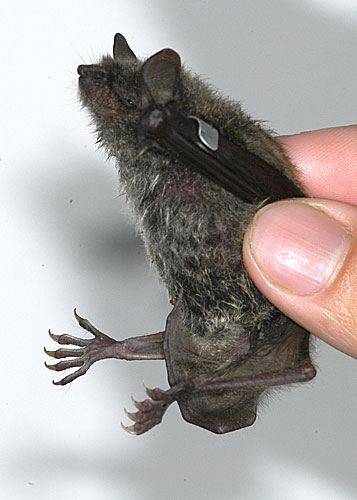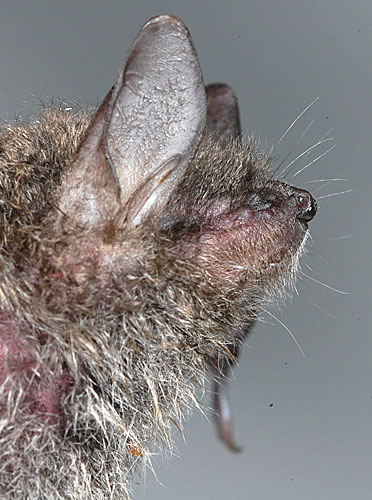Myotis dasycneme
Morphological description Life history Distribution Habitat Roost sites and roosting patterns Emergence and flight pattern Foraging behaviour Echolocation calls Status and protection
A juvenile female bat caught at Dule temple, Tianjin on 7 July 2006 fitted the description of this species. It had large feet (11.4 mm), a forearm length of 43.1 mm, ear length 14.2 mm and < half length of ear (although the overall length is slightly short for M. dasycneme). Given that both western European M. daubentonii and M. nattereri are represented by different eastern species in Asia (M. petax and M. bombinus respectively), this taxon deserves closer attention.
Morphological Description
·Dorsal fur in adults yellow-brown. Ventral fur is paler.
·Forearm length 43 - 49 mm, ear length 17-18 mm (Smith & Xie 2008).
· Long feet t, 11-12 mm (Smith & Xie 2003).
Life history
·One, sometimes 2 young born after a gestation period of about 2 months. Weaning takes 2 moths, and adults can live for almost 20 years (Smith & Xie 2008).
Distribution
Recorded from Shandong in China, and Wang also lists it from Nei Mongol and Heilongjiang. Found across Russia into western Europe.
Habitat
Large areas of water, such as lakes, reservoir, and large still rivers provide important habitats for feeding.
Roost sites and roosting behaviour
·Roosts in caves, tunnels, buildings and hollow trees.
· This species often share their roosts with other bat species, even with swifts (e.g. Temple Dule , Ji county, Tianjin ).
Emergence and flight pattern
· Flight is rapid and agile. Flies fast (7-9 m/s) above the surface of the water (within 0.3 m typically) to catch insects, often touching the water surface to trawl them (Britton et al. 1997).
Foraging behaviour
·Eats aquatic insects, including emerging chironomid midges (Britton et al. 1997).
Echolocation calls
The echolocation call is frequency modulated, though becomes more narrowband in open spaces.
Average values for pond bat echolocation calls emitted during commuting flight, as given by Britton et al. (2007), are listed below:
Interpulse interval: 95 ms; Call duration: 8 ms; Minimum frequency: 28.1 kHz; Maximum frequency: 74 kHz. The maximum power of the call is at a frequency of approximately 36 kHz.
Status and protection
· Pond bats are listed as Near Threatened worldwide, with populations thought to be in decline (IUCN 2008). In China they are considered RL -DD. Caves, old buildings and water courses should be protected as important roost sites.

